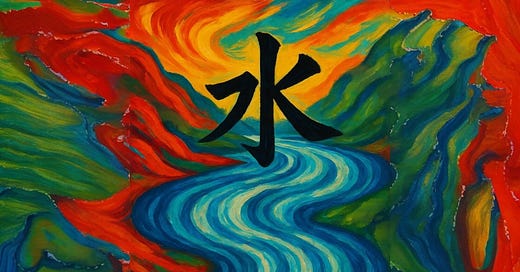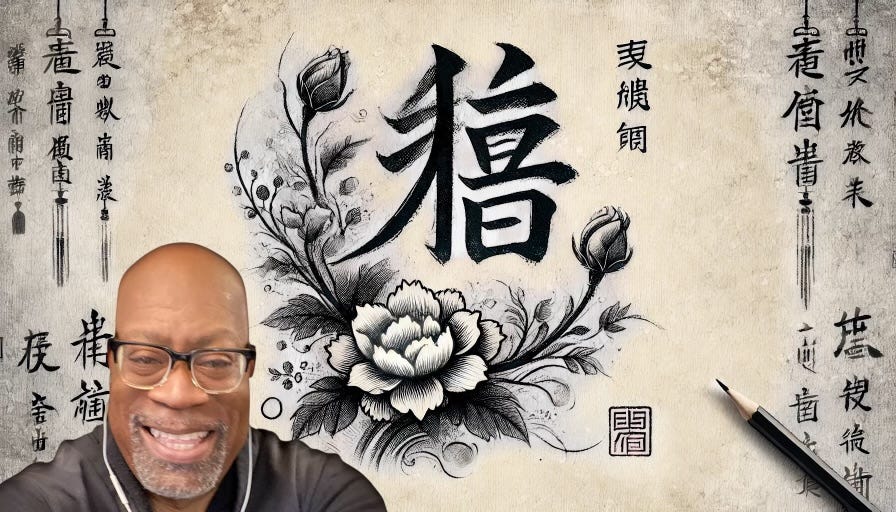The Tao Doesn’t Care About Your Comfort Zone and….
… How to Cross Great Streams in a Flooded Life
The Tao doesn’t hand out participation trophies. It hands you a pair of slick sandals, points to a raging river, and says: “Cross.”
That, in a nutshell, is what Hexagram 5 of the I Ching has been whispering (sometimes screaming) to me: “Crossing the Great Stream.”
On the surface, it sounds poetic, ancient, even gentle. But let’s not kid ourselves. This is Taoist code for “You’re about to enter some serious chaos, and there’s no guarantee you’re coming out dry.”
Great Streams Are Life’s Way of Asking If You’re Serious
In Taoism, water is the ultimate teacher. It flows, it adapts, it yields. But don’t confuse its softness with weakness. Water will drown the arrogant. It will sweep away the unprepared. It will expose every tiny crack in your plan.
That’s what makes crossing a great stream so potent: it’s an invitation to step into the arena of real life. You don’t tiptoe across a great stream. You enter knowing you might lose your balance.
It’s the moment you leave the safety of shore—of old jobs, stale relationships, tired identities—and wade into something raw, untamed, and completely outside your control.
Taoism doesn’t say “don’t be afraid.”
Taoism says to feel the fear, cross anyway, and learn from the water.
The Yellow River Doesn’t Care About Your Itinerary
In ancient China, no river symbolized this dance better than the Yellow River. It was a life-giver and life-taker, nourishing the land one season, destroying it the next. Entire dynasties rose and fell based on the river’s mood. Peasants didn’t argue with the Yellow River. Instead, they respected it, watched the sky, read the wind, and crossed only when conditions allowed.
Today, we face our own Yellow Rivers in the form of global upheavals, career transitions, personal losses, unexpected detours. We pretend we can control these floods with apps, forecasts, and five-year plans. The Tao, well it chuckles at this delusion.
When the floods come, and they always do, they strip away the illusion of control. You are left with nothing but your center. The Taoist teaching is brutally simple: “Find stability within yourself, because the stream isn’t going to get any calmer for your convenience.”
Rain, Floods, and the Raw Beauty of Getting Soaked
The recent deluge across parts of the country has only deepened my meditation on this. Flooding is not just meteorology, it’s a metaphor for how life overwhelms us. Finances collapse. Relationships crack. Health falters. The water rises.
But here’s where Taoism throws a curveball: the flood doesn’t arrive to destroy you. It arrives to reveal you.
Where are your weak spots?
Where have you grown complacent?
Where have you built dams instead of learning to swim?
When life floods your house, you start noticing where the foundation leaks. Same goes for the soul.
The Tao Ain’t Here to Coddle You
Western self-help loves comfort. Taoism is the opposite. The Tao doesn’t promise you’ll feel “good.” It promises reality. It invites you to see clearly: danger and opportunity, collapse and creation, death and rebirth, all swirling together like eddies in the river.
Hexagram 5 isn’t about waiting for perfect conditions. It’s about preparing while you wait. You don’t stand idle. You watch the current. You listen. You read the wind. And when the time comes, you move, not with force, but with harmony.
I’ve learned (usually the hard way) that when I try to bulldoze my way across a great stream, when I try to outsmart, out-plan, out-control, it always ends the same way: face down, gasping, humbled. But when I enter with humility, alignment, awareness, and a willingness to adapt, the river carries me in ways no plan ever could.
The Inner Crossing Is Always the Hardest
Here’s the real kicker most people miss: the most dangerous streams aren’t out there. They’re inside.
The stream of letting go of who you think you are.
The stream of surrendering control.
The stream of allowing life to not answer all your questions.
Most people stay on shore their entire lives. They build safe routines, fortress-like identities, and illusionary guarantees. Taoism calls this spiritual stagnation.
The Tao asks: Are you willing to risk the crossing?
Because on the other side of that stream is not safety, but aliveness.
The Tao’s Final Punchline
And if you think that once you cross, you’re done then think again. The Tao loves to reveal that after one great stream, another waits downstream. The stakes keep rising, but so does your capacity.
The real mastery isn’t reaching some distant shore. It’s becoming the kind of person who doesn’t fear the water anymore. Who can laugh, even while soaked, knowing that every crossing builds the very strength needed for the next.
As Lao Tzu said:
“Because she competes with no one, no one can compete with her.”
I don’t cross to win.
I cross to become.
Would you be kind enough to consider supporting full-time independent writers like me by subscribing today. Or, if you’re feeling generous in a small way, maybe you’ll wanna send a little (or a lot) of dirty chai latte love my direction. Every bit helps keep this Taoist journey flowing.
Diamond-Michael Scott
the chocolate taoist





